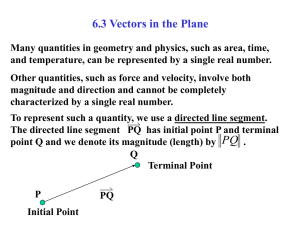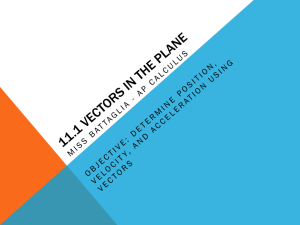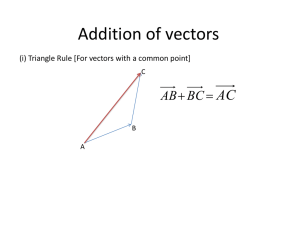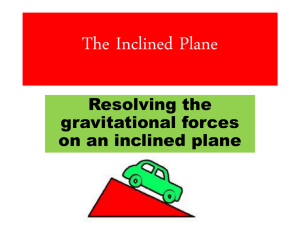Vectors and Advection
advertisement
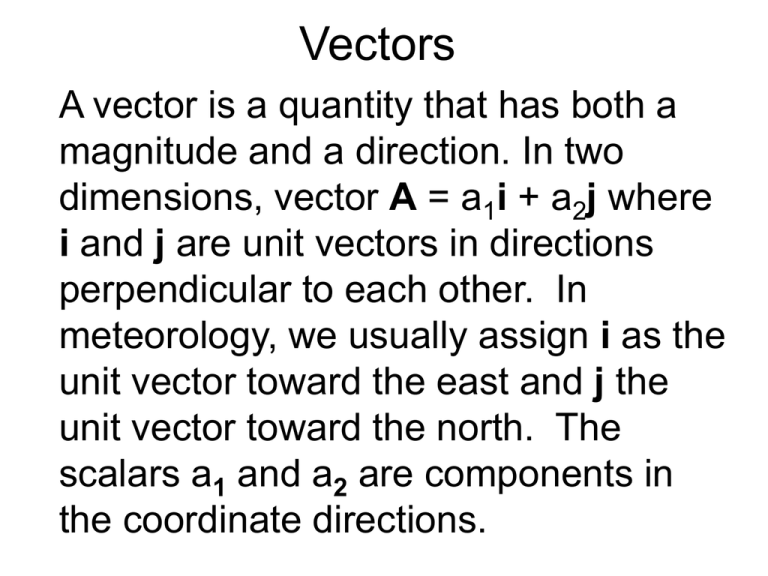
Vectors A vector is a quantity that has both a magnitude and a direction. In two dimensions, vector A = a1i + a2j where i and j are unit vectors in directions perpendicular to each other. In meteorology, we usually assign i as the unit vector toward the east and j the unit vector toward the north. The scalars a1 and a2 are components in the coordinate directions. Vector Addition and Subtraction • For vectors A = a1i + a2j and B = b1i + b2j, the vector sum C = (a1+b1)i + (a2+b2)j. See diagram on the board in class using the diagonal of the parallelogram for A and B. • The vector difference A - B is the vector that must be added to B to get vector A. It is the vector that extends from the tip of B to the tip of A. See diagram on the board in class notes. • Example: Find A+B and A-B for A= -3i -2j and B = 2i -4j. Draw a diagram to show your results. Wind Vector • The horizontal wind V is an example of a two-dimensional vector. If we let V = ui + vj, then u is the east-west component of V and v = north-south component of V. Note that both u and v are scalars. If dd is the meteorological wind direction and ff is the speed in m/s, then • u = ff cos(270-dd), v = ff sin(270-dd). Check if you need to convert argument of sin and cos to radians – multiply by π/180. Example • For a north wind at 20 kt (~10m/s), u = 10m/s cos(270-360) = 0 m/s • V = 10m/s sin(270-360) = -10 m/s • For a southeast wind at 30 kt (~15 m/s), u = 15 m/s cos(270-135) = -10.6 m/s • v = 15 m/s sin(270-135) = 10,6 m/s Magnitude of a vector • The magnitude of a 2-dimensional vector A = a1i + a2j is sqrt(a12 + a22). For the wind vector V, the magnitude (speed) is |V| = sqrt(u12 + v22). In the previous examples, the magniude of the north wind is 10 m/s and the magnitude of the southeast wind is 15 m/s. Gradient of a scalar • Recall that the gradient of a scalar such as temperature T is the rate of change with distance. The gradient of a scalar is always a vector. The magnitude is the rate of change in the direction perpendicular to the contours (isotherms in this case), and the direction is perpendicular to the isotherms toward the higher values (warm air in this case). We use T. Scalar Product (aka dot product) • The dot product of two vectors A and B is A ● B = a1b1 + a2b2 (1) where a1 and b1 are components in the i direction and a2 and b2 are the components in the j direction. We can also write A ● B = |A||B|cosθ (2) where θ is the angle between A and B. Find the dot product of A and B if A = 2i -5j and B = -3i + 6j. Easy way is to multiply components to get 2(-3) + (-5)(6) giving the answer -36. Find it using (2). Thermal Advection • Meteorologists define thermal advection as -V●T where V is the wind vector and T is the temperature gradient in some set of units such as degrees C per 100 km. • Example: Suppose temperature decreases toward the north at the rate of 3oC per 100 km, compute the thermal advection (oC per hr) if the wind is 30 kt (~15 m/s) from the: • a) south, b) north, c) east, d) northwest • For each case, draw a diagram. Terrain-induced Vertical Motion • When air is forced up (or down) a mountain slope, the vertical motion is wo = Vo•h where Vo is the surface wind vector and h is the gradient of terrain elevation. • Example: If terrain slopes upwards toward the south at the rate of 800 m per 100 km, compute the terrain-induced vertical motion if the wind is from: a) southwest at 8 m/s; b) east at 10 m/s; c) 030 degrees at 12 m/s Vector Product (aka cross product) • The cross product C of vectors A and B is a vector with magnitude |C| = |A||B|sinθ where θ is the angle between A and B. We write the cross product C = AxB which is a vector which is perpendicular to both A and B (perpendicular to the plane formed by A and B). Note AxB = -BxA. • The direction of AxB is determined from the right-hand rule. If you use your thumb for A and index finger for B, then your middle finger points in direction of AxB. Vector representation of Geostrophic Wind • We can express the geostrophic wind vector as (g/f) k xz where g = 9.8 ms-2 is the acceleration of gravity, f = 2Ω sinφ is the Coriolis parameter, Ω = 7.292 x 10-5 s-1 is the earth’s rotation rate, and z is the height gradient on a constant pressure surface.





